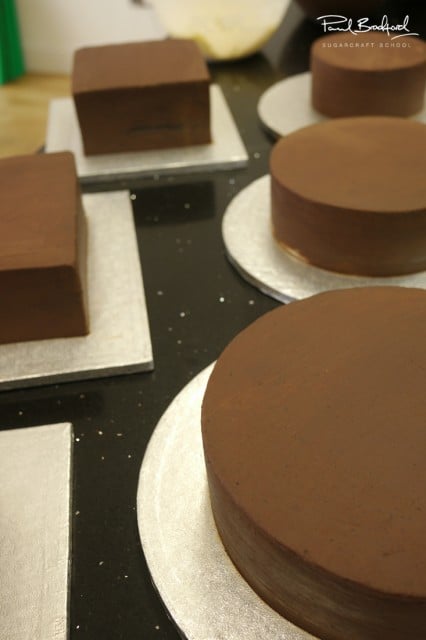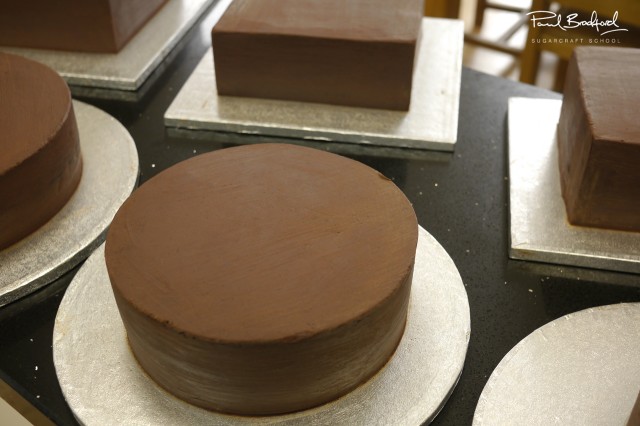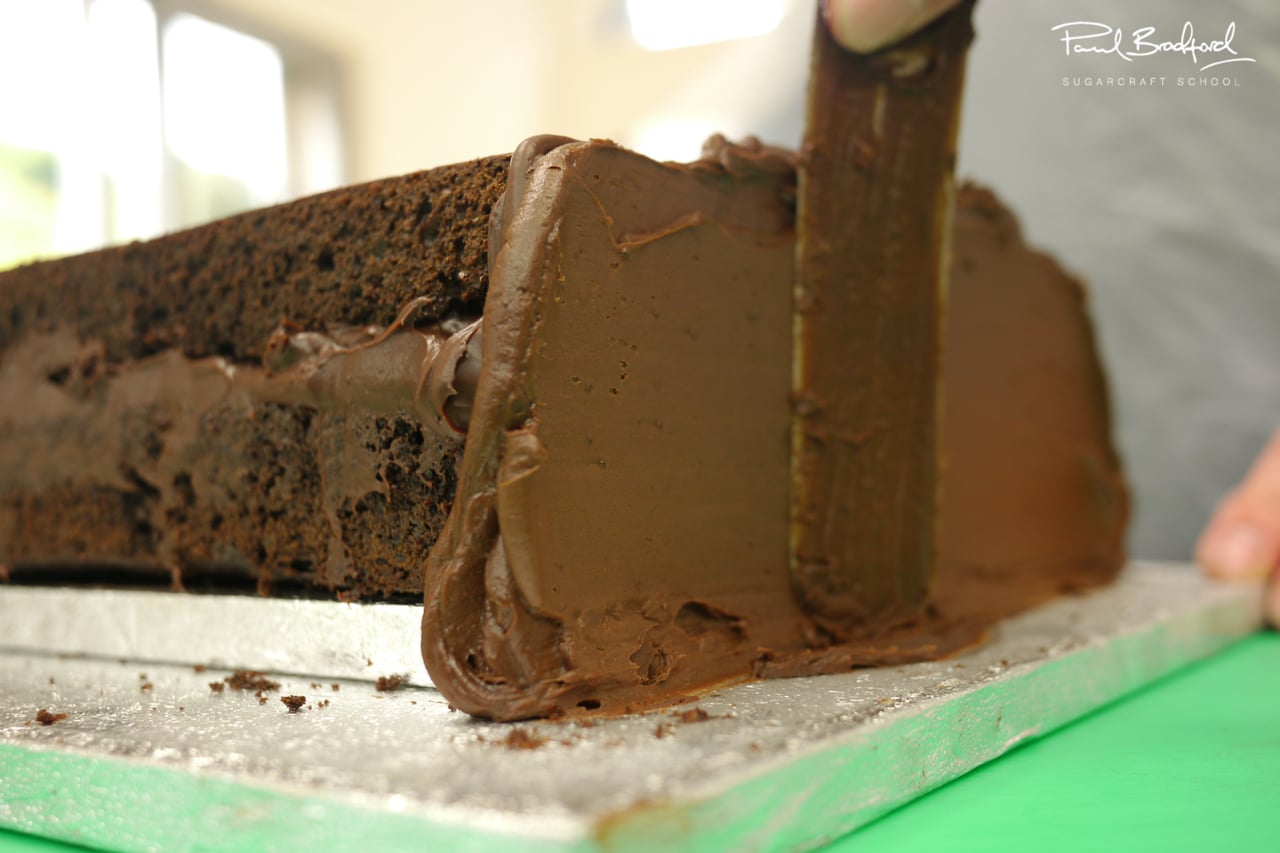For a long while now many members have been concerned with the shelf life of ganache.
Of course, the shelf life of ganache will vary depending on how it is made and for which application it is to be used. In this blog I will attempt to explain some of the science behind the keeping properties of ganache and some of the steps we can take to improve its shelf life.
GANACHE: What is it?
Ganache is an emulsion of chocolate and double cream (or other liquids such as milk, water or fruit puree). It is made by boiling the liquid, which is then poured over small pieces of chocolate. The chocolate melts from the heat of the liquid and the combined ingredients are slowly and carefully stirred together to form a smooth, rich emulsion.
The ganache we use in the tutorials is a basic ganache. It is simply made with two ingredients, chocolate and double cream. The normal proportions for dark chocolate ganache is two parts chocolate to one part cream and for milk or white chocolate three parts chocolate to one part cream. Some adjustment has to be made for hot and humid climates, by increasing the proportion of chocolate to cream. For the purpose of this blog we will only be discussing basic ganache and will not include products such as butter, fruit puree, milk, water, single or whipping cream ganaches. These have additional challenges which cannot be covered here.
 What makes Ganache Spoil ?
What makes Ganache Spoil ?
There are many factors affecting the stability of ganache, but what is most important for us is microbial contamination. Microbes are all around us in their trillions. There are three basic kinds microbe affecting food: bacteria, yeast and mould. Sometimes we can harness microbes to work for us. We culture yoghurt with bacteria, make bread and beer with yeast and Stilton cheese with mould. Uncontrolled, microbes can spoil food and make us ill or even kill us!!
What allows microbes to grow in ganache is water. Water has been described as the enemy of ganache. But it is not that simple. All ganache contains a certain amount of water, but much of it is bound up chemically with the other ingredients. It is the available water, otherwise known as Water Activity (Aw), which affects microbial growth. Aw is measured from one to zero, where one means most active and zero means no activity. As you lower Aw from 0.95 to 0.6, different microbes become inhibited.
If we know the Aw of a food product, we can predict its approximate shelf life. Typically, our basic dark chocolate ganache has a Water Activity (Aw) of around 0.86 and white chocolate ganache a little lower, although dark chocolate ganache keeps better because the cocoa content inhibits microbial growth. With correct handling of implements and ingredients we can expect this ganache to keep for up to three weeks. Under certain conditions, it may even keep a lot longer.
As you can see water activity is very important. It can be measured by using a Water Activity Meter, such as a Decagon Aqua Lab Series 3
http://www.aqualab.com/products/water-activity-meters/pawkit/.
They are not cheap with a starting price of £1,100. But anyone employed in a professional kitchen, working regularly with chocolate, should consider getting one.
Alternatively, if you’re very concerned, you can take your made ganache to local food testing laboratories to have your ganache tested. There will be a charge. This varies from areas to area. In my area the charge last year was £ 25.00, although I am told it can run into hundreds.
How to improve the keeping properties of Ganache.
Keep in mind that when you open your container of cream it becomes contaminated with airborne bacteria and other weird and wonderful fungal spores. By boiling the cream you not only kill any microbes entering the system, but also remove some of the water in the boiling process. If the cream is boiled three times, resting for a minute between boils, some water evaporates away.
To further increase shelf life, glucose liquid or invert sugar can be added to the cream at the boiling stage. For every kilo of ganache add 50g of syrup which is 5%. (We can also use invert sugar, corn syrup, glycerol and/or sorbitol). Don’t add more because it can change the mouth feel and consistency of the ganache. Invert sugars or glucose syrup, added to ganache, helps to reduce available water (Aw) by chemically bonding with the water making for a more stable ganache at room temperature. Other factors to consider include the working ambient temperature of your kitchen/workroom, ideally 20oC or less. Although you can work with ambient temperatures up to 25C, which I wouldn’t recommend, the ganache will take a long time to set.

Obviously cleanliness of working area, equipment, storage and handling must be factored in.
Don’t whip ganache because it incorporates large volumes of air increasing microbial exposure. If you want to whip ganache for fillings the best way is to use a tall receptacle and stick blender. Keep the blender right down at the bottom of the receptacle to ensure not too much air incorporates during whipping.
Last but by no means least, you can also add a tablespoon or two of your favourite tipple into made ganache. The alcohol used should be at least 40% proof. When the alcohol is first added to the ganache it will look split. Gently, keep mixing and it will emulsify. Personally, I do use lots of alcohol in my ganaches, but I tend not use glucose or invert sugar unless I am making chocolates for prezzies.
Cover the ganache with cling film, so it touches the surface of the ganache to exclude air. If your ganached cake is awaiting enrobement keep it covered in cling film to protect from airborne microbes and moisture.
Storing the product in a refrigerator (4 – 8oC) will increase shelf life considerably. Storing at 15oC or below will still increase shelf life.
Guys, I’m not a scientist or an expert, but I learnt a lot of this stuff on a course I was lucky to have attended earlier this year at the Callebaut Chocolate Academy and I wanted to share what I have learnt with you all. The course was about the science of extending the shelf life of ganache in chocolate making. However, I have applied some of the information to caking.
This is how I make my ganache and I have no problems. I’ve left ganache out on the kitchen counter for a month without seeing any mould growth. This doesn’t mean I would eat it!
The science behind ganache is far more complex than my little explanation here. Please do some research of your own, make test samples in your own kitchen and see what holds best for you. My ganache may not necessarily have stability in your kitchen and visa-versa.
Happy ganaching folks!
madeitwithlove xx


